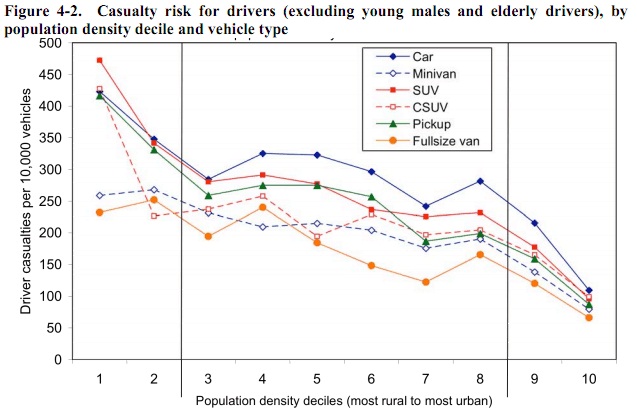 Cross-posted from Sightline Daily.
Cross-posted from Sightline Daily.
You might think that vehicle safety studies are all about the crash dummy tests you see on TV, with simulated collisions. But those kinds of tests don’t tell you how often collisions occur. A car that does well in a simulated crash test might not actually be all that safe in the real world, particularly if it’s bulky and hard to maneuver on on the road.
And that’s what Dr. Tom Wenzel of the Lawrence Berkeley National Laboratory has pointed out repeatedly over the past decade: Bigger vehicles like SUVs aren’t always safer vehicles.
There’s a lot of food for thought in Wenzel’s report from last March on the relationship between vehicle size and safety [PDF] — which, as far as I can tell, is the most comprehensive and best-documented review of the relationship between vehicle size and real-world safety records.
This study is his most sophisticated look at the topic to date, since it looks not only at real-world crash and fatality records of different makes and models, but also at the kinds of drivers who are involved in the crashes, as well as the the kinds of places that crashes occur. Not too surprisingly, he finds that young males and elderly drivers crash more than the average driver.
Crash fatalities are more common in rural areas than in urban areas; in fact, measured by fatalities per vehicle, the densest urban areas are also the safest places to drive. (See the chart to the right; click it to enlarge). But Wenzel is mostly interested in the inherent safety of the vehicles themselves — so his analysis excludes crashes in the most rural and most urban areas, and among higher-risk demographic groups.
The end result is a nuanced take on the relationship between vehicle size and vehicle safety. For example, he finds that …
- Heavier cars do, in fact, tend to be safer than lighter cars;
- Midsized cars are slightly safer than mid-sized SUVs, and compact cars are on a par with small SUVs.
- “Compact SUVs” based on car-body designs are actually safer than the larger, heavier fullsize SUVs based on truck designs;
- For vans, pickups, and fullsize SUVs, gains in safety to drivers are typically offset by increased risks to drivers of other vehicles; and
- There’s a lot of variation in the data: The size of vehicle is just one factor among many when trying to choose a safe car.
(Most of these findings are taken from Figure 4-6 and Figure 4-7 in the report.)
In short, Wenzel finds that there is a relationship between vehicle size and safety — but it’s a different relationship for different kinds of vehicles. People who chose a big SUV because it seemed “safer” than a car in a collision were often making a bad decision; a smaller CSUV, or even a large car, might have offered a safer ride. Similarly, people who chose a big SUV over a smaller one for “safety” reasons were often just increasing the risks they pose to other drivers.
But perhaps the biggest lesson of all is in the chart above: If you want to stay safe, your best bet is to live in a place where you don’t have to drive much. The casualty differences between a compact urban neighborhood and a suburb are much greater than the relatively minor safety gains from getting a slightly bigger car. Which suggests that if you really want to drive safely, your best option is to drive less.




